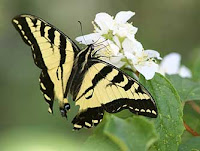The Western Tiger Swallowtail (Papilio rutulus) is a common swallowtail butterfly of western North America, frequently seen in urban parks and gardens as well as in rural woodlands and riparian areas. It is a large, brightly colored and active butterfly, rarely seen at rest; its wingspan is 7 to 10 cm, and its wings are yellow with black stripes, and in addition it has blue and orange spots near its tail. It has the "tails" on the hind wings that are often found in swallowtails.
A deep green, shiny, spherical egg is laid on the underside of a leaf. Eggs are laid singly, but there may be a number of them on the leaf. The caterpillars of Western Tiger Swallowtail, reach about two inches in length, are deep to light green in color, are swollen in the front, and have large yellow eyespots with black and blue pupils. There is a colored forked organ called the osmeterium located behind the head on the back of the caterpillar. This foul-smelling organ can turn inside out, and, along with the eyespots, may deter predators. The dark brown chrysalis overwinters slung from a twig or tree trunk. The chysalis is woodlike.
 Swallowtail females may lay up to four batches of eggs in a season and up to one hundred eggs in total. The length of time that it takes for the larvae to emerge from the egg depends upon the weather, but generally, in summer, it takes four days. The larvae molt five times - called instars - before they pupate. After each molt, the caterpillar eats the old skin which is rich in nutrients.
Swallowtail females may lay up to four batches of eggs in a season and up to one hundred eggs in total. The length of time that it takes for the larvae to emerge from the egg depends upon the weather, but generally, in summer, it takes four days. The larvae molt five times - called instars - before they pupate. After each molt, the caterpillar eats the old skin which is rich in nutrients.

 8:14 PM
8:14 PM
 sadmovement
sadmovement



 Posted in:
Posted in: 






0 comments:
Post a Comment